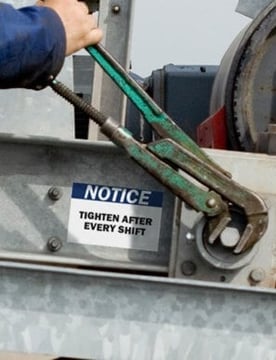Starting and Sustaining a Safety Program
03
February,
2023
2 MINUTE READ

No one could have predicted that 2020/2021 would be the years of the workplace safety manager. Proactive health and protection efforts have been a huge focus throughout the world since the onset of the novel coronavirus, or COVID-19. Pandemic or not, creating and maintaining workplace safety should be a priority. Surprisingly, many facilities still do not have formal plans. Workplaces need to pivot, modify, or even build safety plans. Industrial safety solutions and communication from start to finish are crucial.
Establish a Foundation
One mega-retailer who took the time to re-evaluate its safety program this year is Amazon. It recently partnered with the National Safety Council to improve rates of musculoskeletal disorders. The goal is to cut its recordable incident rate by 50% in four years.
"Nothing is more important than the safety of our employees, and this partnership will allow us to dive deep into the best way to reduce MSDs," said Heather MacDougall, Amazon's vice president of worldwide workplace health and safety.
Employers have a responsibility to create and maintain workplace safety plans that follow OSHA regulations and important standards. When workplaces do not have a strong safety plan or do not enforce safety plans, costs can incur through stoppages, worker injuries, and machinery damage.
Each year, employers pay out more than $55 billion in workers' compensation for on-the-job injuries and illnesses, according to OSHA. In a recent OSHA study, claims fell by an average of 50 percent or more for a group of small employers after using OSHA-sanctioned safety plans.
What are some ways environmental health and safety managers improve safety in their workplaces?
"Start with compliance," said Josh White, a health and safety manager in Indiana. "Once you have that down slowly build. Too much too soon leads to massive rebellion."
"To me, the first thing is to get management buy-in," said Tim Kohanski, a longtime EHS manager in New York. "You can make progress without it, but it won't be sustainable. Make it public. Get the vice president of whatever to address everyone and say, ?Hey, safety is a priority.' Make them put their name to it."
Management Methods

Company buy-in and compliance are great places to start a structured plan to control safety risks. Whether starting or updating a workplace safety program, here are additional elements to take to keep the program moving forward and successful.
- Specific hazards: Control the hazards that affect workers the most. Stop unsafe behavior, listen to workers' concerns, welcome feedback, and look at near-miss data. Monitor, supervise, report, and act.
- Policies: Make sure policies for procedures and processes line up with the company's safety goals as well as safety best practices outlined by expert organizations related to your industry, such as the Electrical Safety Foundation, the Society of Manufacturing Engineers, to name a few.
- Training: Teaching employees about safe behavior is not a one-time event. Supervise regularly and host safety meetings periodically. Encourage a workforce that aims to improve qualifications.
"One mistake I made-after you create, implement, and train on the new [safety] program, don't just run to the next problem," said Lauren Thomas, an EHS manager in Texas. "Make sure you keep auditing/reviewing the new program to ensure it sticks and that people continue to follow it."
Safety management requires attention to potential risks, understanding ways to control hazards, and communicating needs, solutions, and feedback. Create structured management to control safety risks, then use specific structures and processes for safety. Then, reinforce safety expectations with visual controls such as signs, labels, and floor marking. Visual communication helps maintain workflow, including 5S and other lean management plans. It also reminds workers of important protocols, including when PPE is necessary. This ensures a solid safety management plan that can be as flexible as your facility needs.
RELATED RESOURCES

3 Ways to Reinforce Training and Improve Safety
Training employees isn't a one and done type event. Training should be continuous as job tasks and hazards ...
Read
Want to Save Money? Invest in Workplace Safety
Some of the top workplace incidents are often the most costly, according to recent data from Liberty Mutual. ...
Read
OSHA Increases Penalties for 2021
As of Jan. 15, 2021, OSHA's civil penalties for violations of workplace safety and health standards are 1.8 ...
Read.png)


